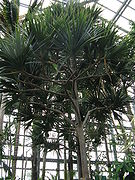
Pandanales, the pandans or screw-pines, is an order of flowering plants placed in the monocot clade in the Angiosperm Phylogeny Group and Angiosperm Phylogeny Web systems. Within the monocots Pandanales are grouped in the lilioid monocots where they are in a sister group relationship with the Dioscoreales. Historically the order has consisted of a number of different families in different systems but modern classification of the order is based primarily on molecular phylogenetics despite diverse morphology which previously placed many of the families in other groupings based on apparent similarity. Members of the order have a subtropical distribution and includes trees, shrubs, and vines as well as herbaceous plants. The order consists of 5 families, 36 genera and about 1,610 species.

Pandanus is a genus of monocots with some 578 accepted species. They are palm-like, dioecious trees and shrubs native to the Old World tropics and subtropics. The greatest number of species are found in Madagascar and Malaysia. Common names include pandan, screw palm and screw pine. They are classified in the order Pandanales, family Pandanaceae.

Pandanus tectorius is a species of Pandanus (screwpine) that is native to Malesia, Papuasia, eastern Australia, and the Pacific Islands. It grows in the coastal lowlands typically near the edge of the ocean. Common names in English include thatch screwpine, Tahitian screwpine, hala tree and pandanus. The fruit is edible and sometimes known as hala fruit.

Pandanus spiralis is native to northern Australia. It is commonly called common screwpine, iidool, pandanus palm, screw pine, screw palm or spring pandanus. It is neither a true palm, nor a pine.

Pandanus balfourii, also known as Vakwa bordmer, is a species of plant in the family Pandanaceae, one of four Pandanus species that are endemic to the Seychelles.

A stem is one of two main structural axes of a vascular plant, the other being the root. It supports leaves, flowers and fruits, transports water and dissolved substances between the roots and the shoots in the xylem and phloem, photosynthesis takes place here, stores nutrients, and produces new living tissue. The stem can also be called halm or haulm or culms.

Pandanus odorifer is an aromatic monocot species of plant in the family Pandanaceae, native to Polynesia, Australia, South Asia, and the Philippines, and is also found wild in southern India and Burma. It is commonly known as fragrant screw-pine.
Pandanus laxespicatus is a screwpine or pandan of the wetlands of Madagascar, and belonging to the monocot family Pandanaceae. It was of fairly recent discovery, having been unknown to science prior to 1951 when described by Martelli and Pichi-Sermolli. For the next seventeen years, it was just another member of a large family, but in 1968 Dr. Benjamin C. Stone discovered that at a certain stage of its growth it produces the longest linear (ribbon-like) leaves of any known plant; up to 33 feet in length and 14 inches in width. P. laxispicatus belongs to the same section (Acanthophylla) as P. pulcher. P. odorissimus and P obeliscus, which are known collectively as the Coniferoids, because their numerous side branches cause them to resemble huge Christmas trees. The very large leaves are known as "crown megaphylls" and sometimes have the appearance of a green "star" at the top of the tree. As the megaphylls fall away with age, they are replaced by side shoots of much smaller leaves which account for the conifer-like appearance of the mature trees.

Pandanus heterocarpus is a species of plant in the family Pandanaceae. It is commonly called the "Rodrigues screwpine", known locally as "vacoa parasol" or "vacoa cale rouge". It is endemic to the island of Rodrigues.

Pandanus rigidifolius is a species of plant in the family Pandanaceae, endemic to Mauritius.

Pandanus glaucocephalus is a species of plant in the family Pandanaceae, endemic to Mauritius.
Pandanus barkleyi is a species of plant in the family Pandanaceae, endemic to Mauritius.

The karuka is a species of tree in the screwpine family (Pandanaceae) and an important regional food crop in New Guinea. The nuts are more nutritious than coconuts, and are so popular that villagers in the highlands will move their entire households closer to trees for the harvest season.

Pandanus simplex is an economically important species of Pandanus (screwpine) endemic to the Philippines. It is commonly known as karagumoy or kalagimay. Its leaves and fibers are used widely in the Philippines for thatching, ropes, and weaving various traditional handicrafts like baskets and mats.
Pandanus erectus a species of plant in the family Pandanaceae. It is native to Madagascar, described growing in secondary forest in the Maroantsetra area of NE Madagascar. Some references list Pandanus concretus as the accepted name, with Pandanus centrifugalis, P. dauphinensis, P. erectus and P. madagascarensis as synonyms.
Pandanus spicatus a species of plant in the family Pandanaceae. It is native to Madagascar.
Pandanus pluriloculatus is a dioecious tree in the family Pandanaceae which is endemic to Madagascar. The specific epithet, pluriloculatus, is a reference to the numerous locules in a compound ovary.
Pandanus subglobosus is a dioecious tropical shrub in the screwpine genus. It is endemic to Madagascar. The specific epithet, "subglobosus", refers to the nearly-round fruits. The accepted name for this species is now Pandanus oligocarpus.

Pandanus gemmifer, commonly known as pup pandan, is a plant in the family Pandanaceae that is endemic to northeast Queensland. It is closely related to Pandanus grayorum and Pandanus solms-laubachii.

Benstonea monticola, commonly known as scrub breadfruit or urchin-fruited pandan, is a plant in the family Pandanaceae which is endemic to rainforested parts of north east Queensland, Australia.























